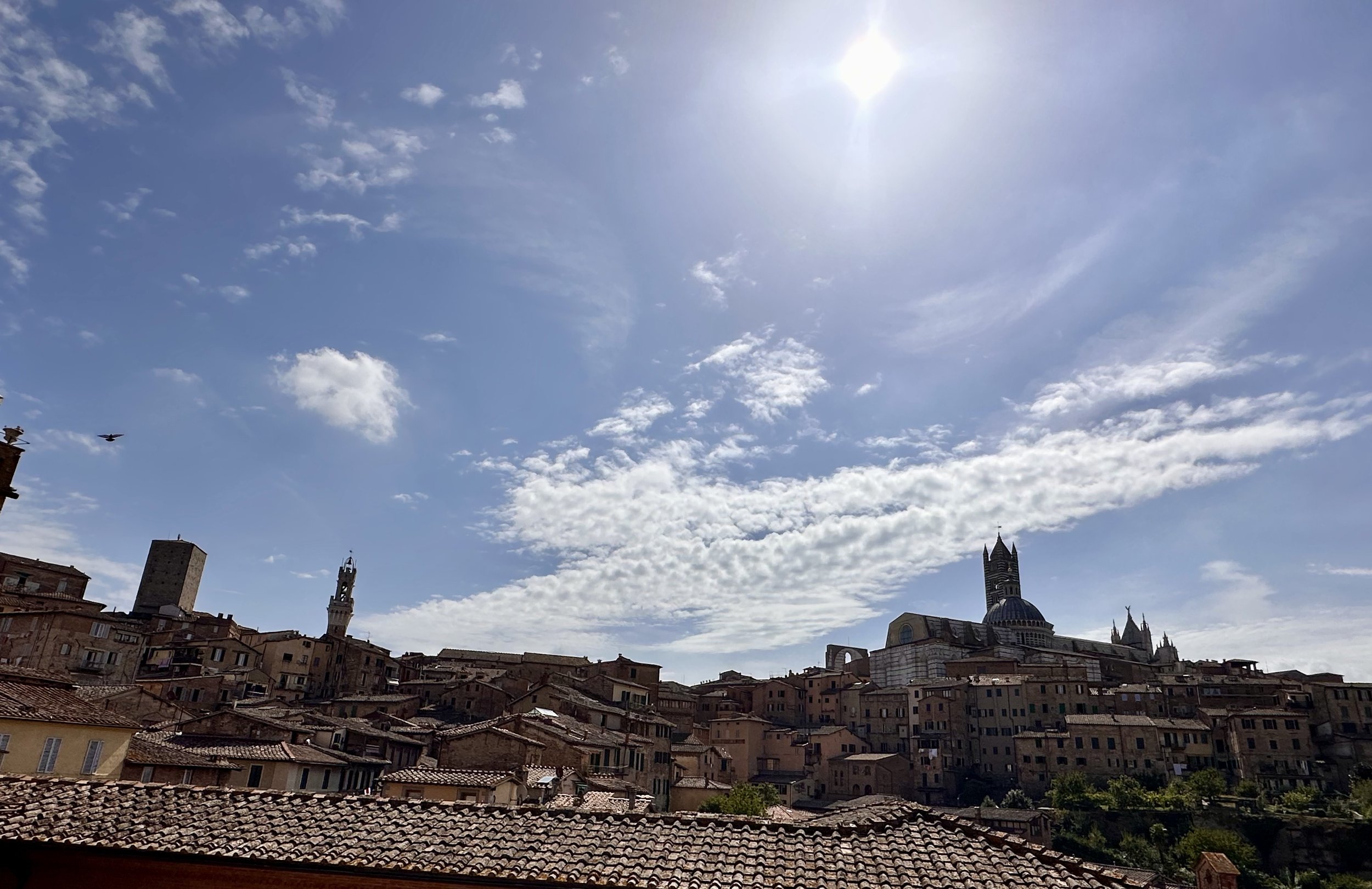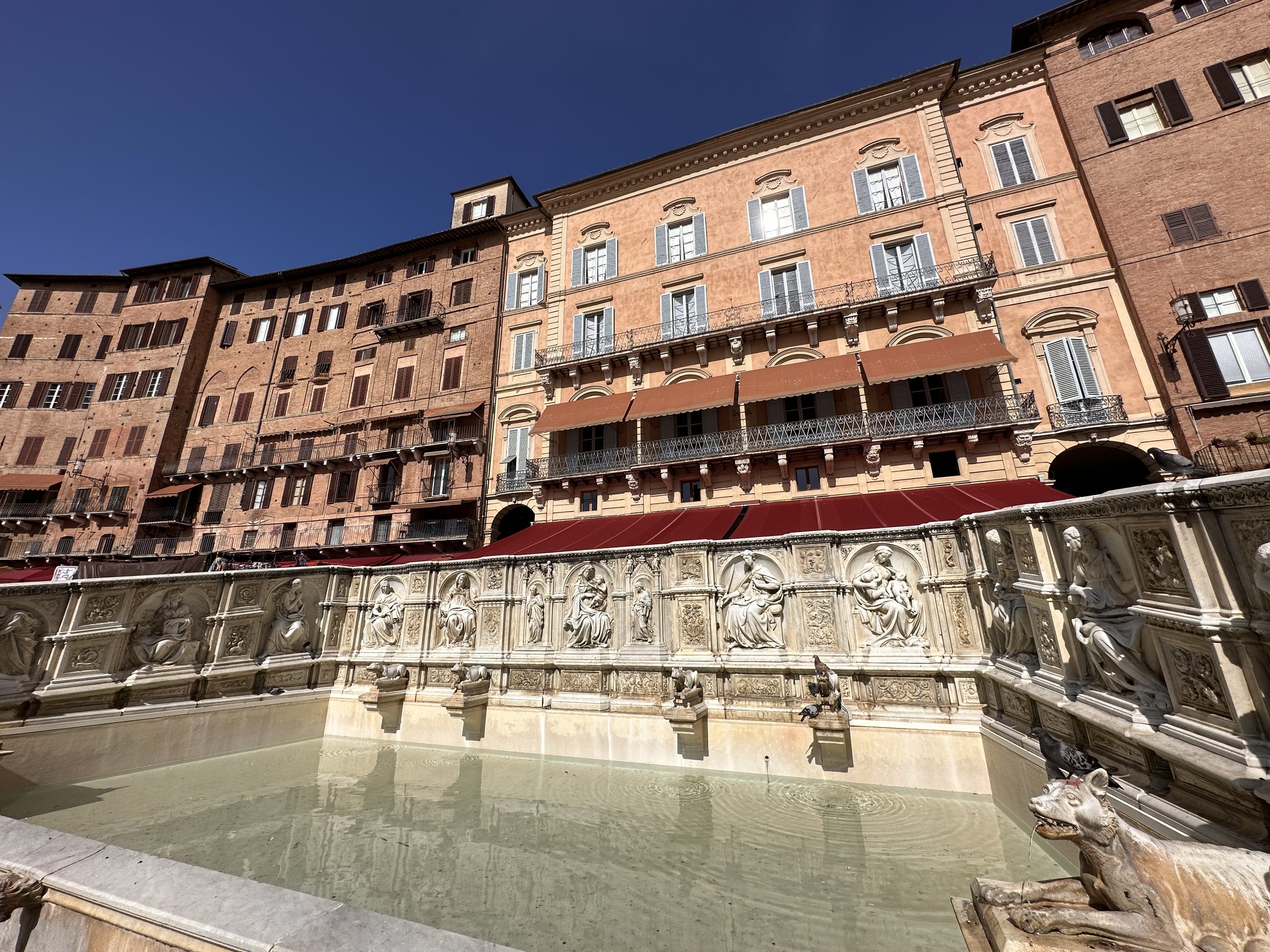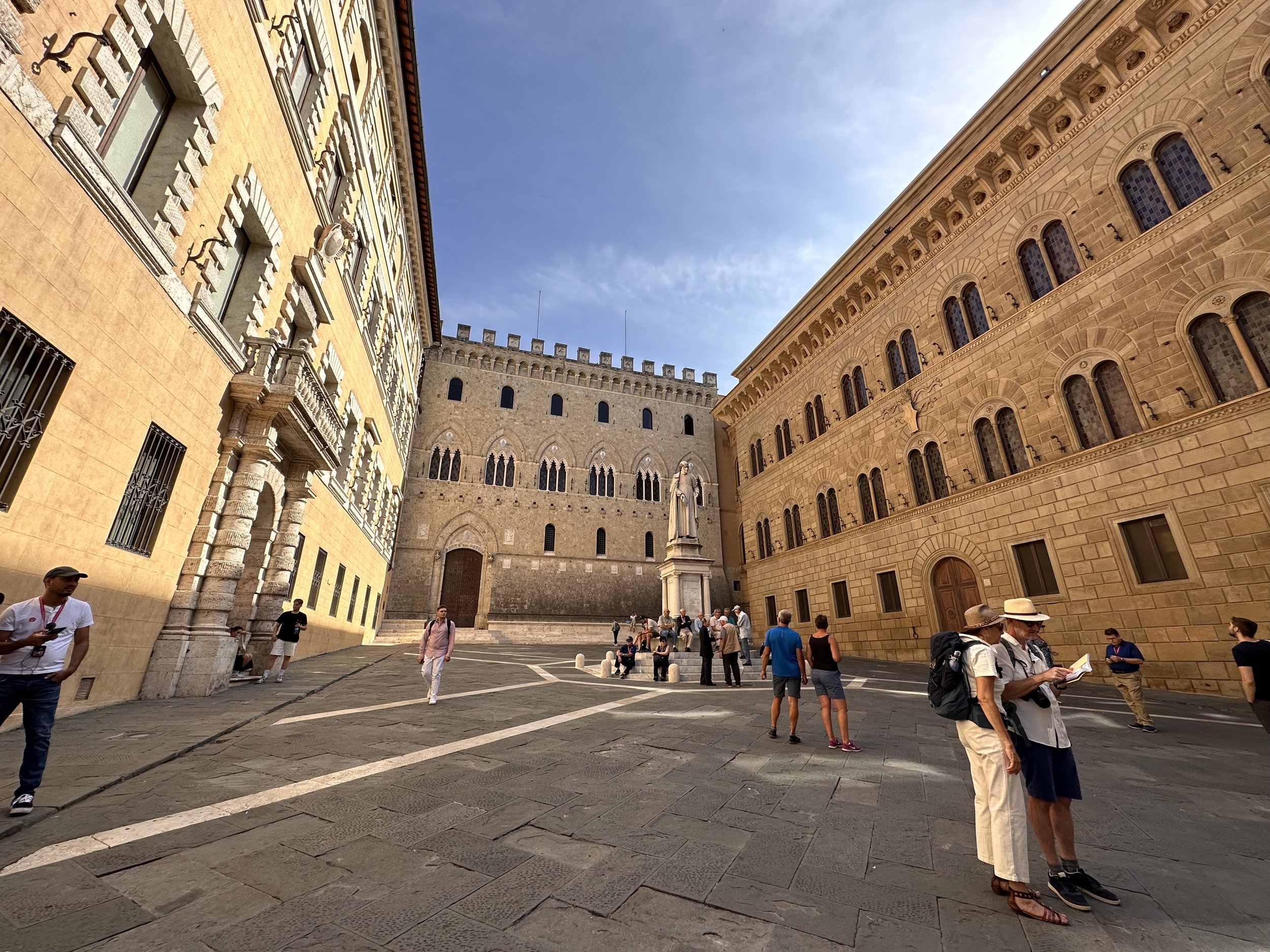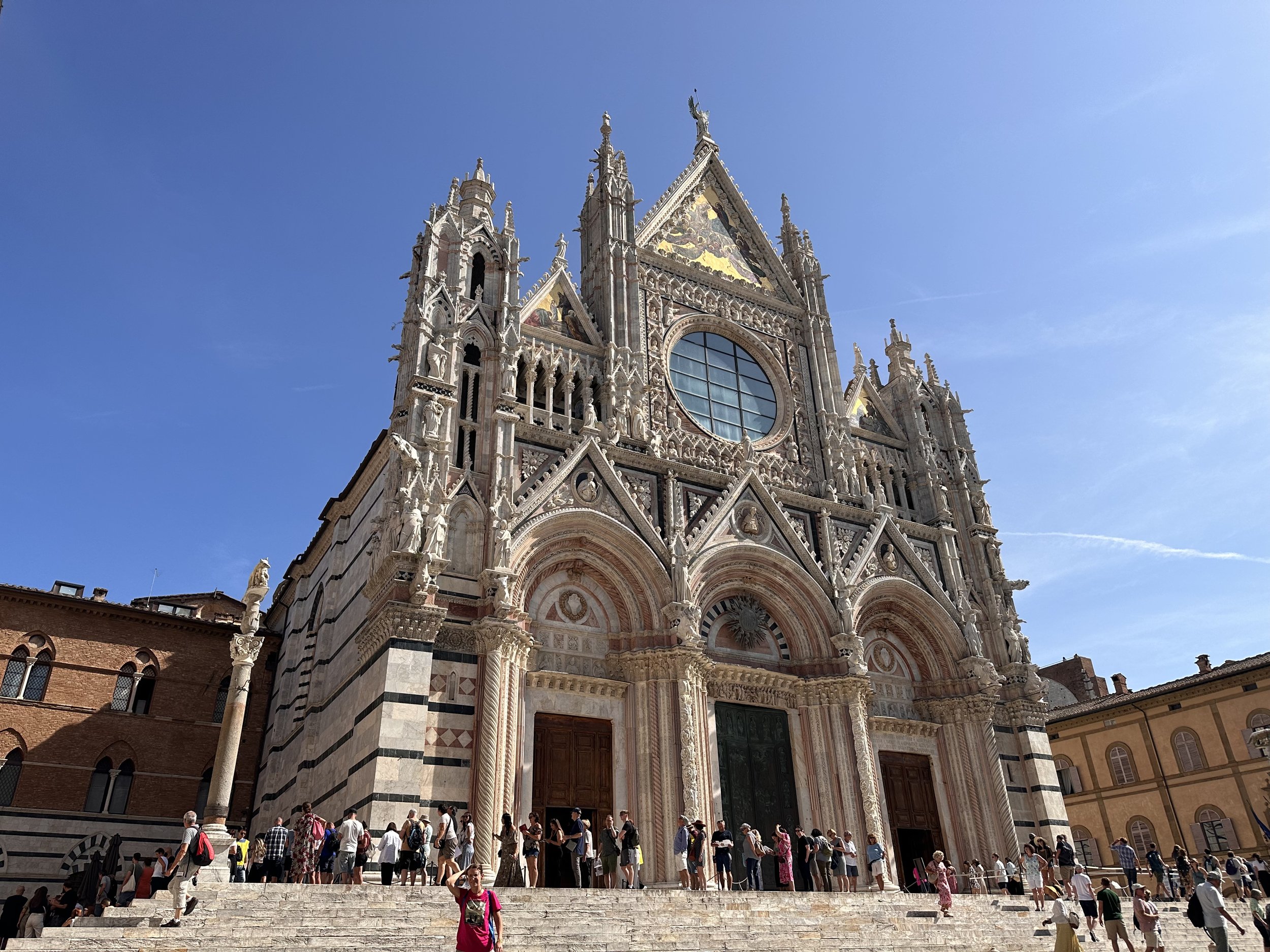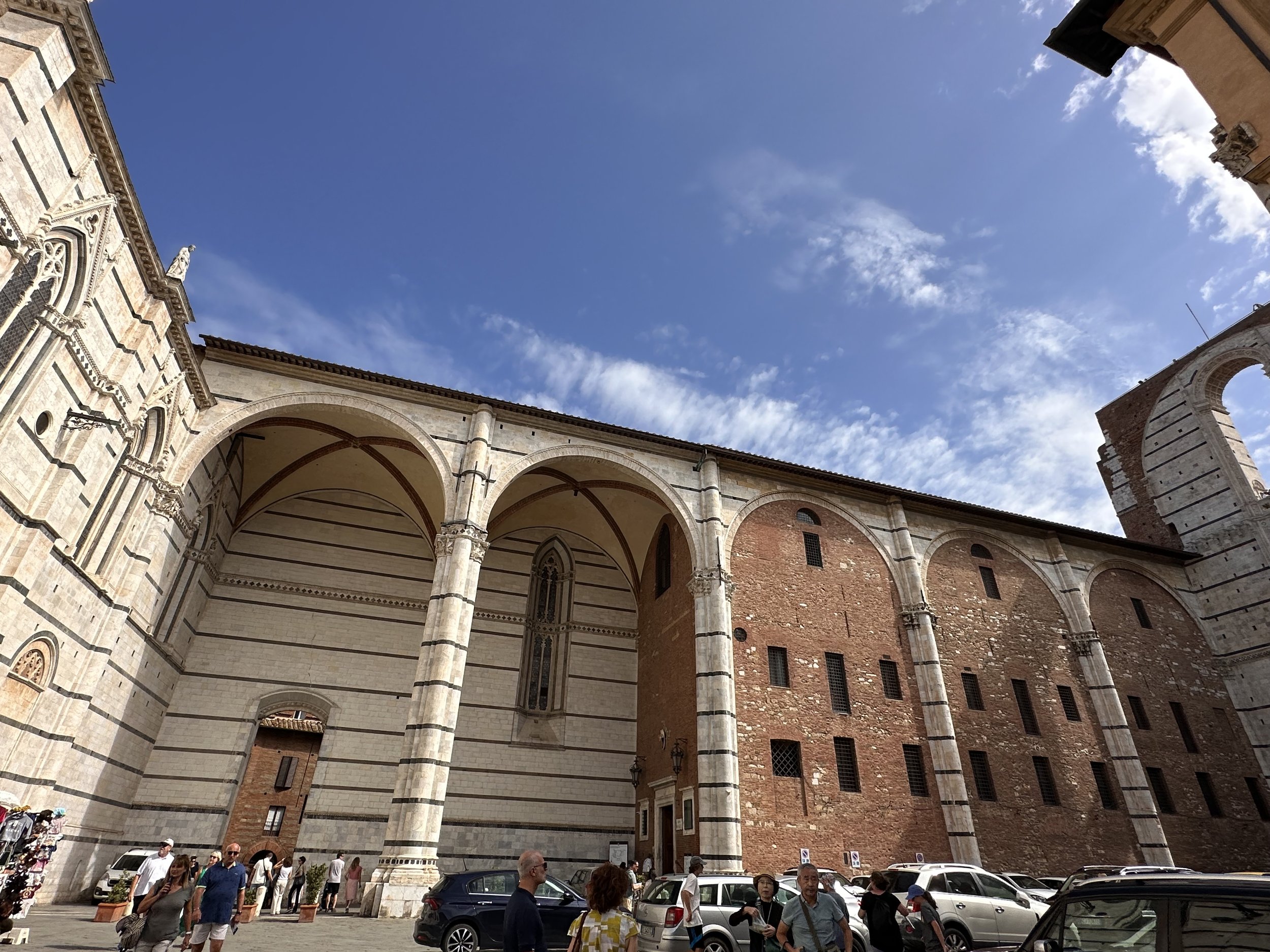Exploring Siena, Italy
Time needed in this town: A day trip or 1 night
While merely a day trip, it’s an unforgettable one. Siena remains virtually untouched throughout time and has been the backdrop for many famous movies. While you only need a few hours, it’s absolutely worth it!
The below information is a complete guide of the best places to stay, the top rated places to dine and drink, and all there is to see and do. We’ve also included transportation tips, as well as a summary of the history of this incredibly preserved town!
Jump To:
Where to Stay
Siena is a perfect day trip from Florence. However, if you should choose to stay the night, below are some recommendations:
Where to Dine & Drink
Il Calice
Top-rated! Homemade Italian cuisine
La Piccola Ciaccineria
A pizzeria
La Taverna di San Giuseppe
Elevated Tuscan dishes in a charming, brick-&-stone space with an ancient Etruscan cellar.
Osteria degli Svitati
Cozy, relaxed restaurant with exposed-brick walls offering cold cuts & traditional dishes.
Osteria Il Carroccio
Traditional Italian cuisine
Osteria La Sosta di Violante
Siena-style pastas, meat dishes & desserts with creative contemporary flourishes, plus local wines.
Osteria Permalico
Relaxed restaurant serving traditional local dishes & wine in a cozy, brick-lined dining space.
Particolare di Siena
A fine-dining restaurant which changed tack in 2020, reducing its number of tables to just ten and embracing a sustainable approach to its cuisine.
Quarto Bistrot
Upscale French-inspired Italian cuisine
Ristorante Campo Cedro
Serving modern and skilfully prepared Italian dishes which are fresh, elaborate and influenced by the Mediterranean.
Ristorante La Locanda dei Tintori
Traditionally furnished eatery offering unpretentious regional dishes in an intimate dining area.
Ristorante San Domenico
A Tuscan, gluten-free pizza and pasta restaurant with the most amazing views of the Siena skyline!
Ristorante Tar-Tufo
Traditional Italian food
Things to See & Do
Basilica Cateriniana San Domenico
St. Catherine spent a large part of her life inside the walls of this Basilica, which was one of the first to be dedicated to St. Dominic. It was begun by the Dominicans in 1226 on the hill of Camporegio, which they had received as a gift from the Malavolti family.
The Church contains a magnificent Maestà by Guido da Siena dating back to 1221. The old Chapter Room, the old Sacresty, the Refectory, and the Dormitory were all built with the original Church and the Cloister was frescoed by Lippo Memmi and Lippo Vanni.
In the first half of the 14th century, the new Church (crypt and transept for the old Church) was built on the steep side of Camporegio hill overlooking the district of Fontebranda where St. Catherine had been born. When she began going to St. Dominic, the new edifice was already almost finished. Her own father and other members of her family were buried in the Crypt.
Following the canonisation of St. Catherine in 1461, her most precious manuscripts and her sacred relics were transferred to the Basilica (these twelve codices in 1700 were placed behind a painting above the altar in the Scaresty and formed the so-called "virginal library": today they are in the public library). The most important relic, the Sacred Head, was brought from Rome to Siena in 1383 and was, at first, placed in a copper container and then in a silver one (now empty but still on display in the Basilica). In 1711 it was moved to a urn, in the form of a lamp, done by the sculptor Giovanni Piamontini where it remained until 1947, when the Dominican Fathers decided to place it in its actual urn of silver in a niche resembling a small gothic temple.
After nearly 200 years of construction, the Basilica was finally dedicated entirely to St. Catherine and a statue of her was placed at the top of the bell tower.
In 1798, the basilica was almost totally destroyed by an earthquake, though completely restored shortly thereafter. Unfortunately, it was very much neglected and allowed to decay until 1940 when a new restoration finally began - it completed 22 years later in 1962.
Today, the Basilica is exactly as the Dominican Fathers have always wanted it to be and it has become an important center of Christian spirituality where pilgrims are welcomed and where they can pray next to the sacred relics of St. Catherine.
Duomo di Siena
The origins of the first structure are obscure and shrouded in legend. There was a 9th-century church with the bishop's palace at the present location. In December 1058, a synod was held in this church resulting in the election of pope Nicholas II and the deposition of the antipope Benedict X.
In 1196, the cathedral masons’ guild, the Opera di Santa Maria, was put in charge of the construction of a new cathedral. By 1215, there were already daily masses said in the new church. There are records from 1226, onwards, of the transport of black and white marble for the construction of the façade and the bell tower. The vaults and the transept were constructed in 1259–1260. In 1259, Manuello di Ranieri and his son, Parri, carved some wooden choir stalls, which were replaced about 100 years later and have now disappeared. In 1264, Rosso Padellaio was paid for the copper sphere on top of the dome.
A second massive addition of the main body of the cathedral was planned in 1339. It would have more than doubled the size of the structure by means of an entirely new nave and two aisles ranged perpendicular to the existing nave and centered on the high altar. In 1348, construction was halted by the Black Death and never resumed. The outer walls (remains of this extension), can now be seen to the south of the Duomo. The floor of the uncompleted nave now serves as a parking lot and museum, and, though unfinished, the remains are a testament to Sienese power, ambition, and artistic achievement. One of the walls can be climbed by narrow stairs for a high view of the city.
Underneath the choir of the Duomo, a narthex containing important late 13th-century frescoes was found and excavated in 1999–2003. The frescoes depict scenes from the Old Testament and the life of Christ. This was part of the entrance of an earlier church. But, when the baptistry was built, this under-church was filled with rubble. The narthex is now open to the public.
There are many things to see in the Duomo di Siena and none should be missed. This includes:
TIP: To explore all of the aforementioned areas, purchase the “Porta del Cielo Pass”.
Fonte Gaia
The Fonte Gaia is a monumental fountain located in the Piazza del Campo in the center of Siena. It’s the first fountain in the Piazza del Campo, and was completed in 1342, after hydraulic construction had led water to the site from 25 kilometers away.
Legend holds that the fountain was met with much joy, thus it was given the name “Gaia” or joyous. Others suggest the term Gaia refers to the Latin term for "bride", and that the fountain was dedicated to the bride of God and patron of Siena, the Virgin Mary.[2] The fountains, plates, and statues conflate Roman matrons' cardinal virtues, with a central relief of the Madonna and Child, curiously framed by stories of Genesis.
In 1419, the fountain had the present decorative frame constructed by Jacopo della Quercia. In 1858, the original marble panels were replaced by copies. The side reliefs depict episodes from Genesis: The Creation of Adam and The Flight from the Garden of Eden. The wolves spouting water, representing the mother-wolf of Remus and Romulus, form part of the reconstructed fountain. Two nude female figures once adorned the front two columns, traditionally believed to represent Rea Silvia and Acca Larentia, in celebration of Siena’s supposed links to ancient Rome. These were not added in the reconstruction but can be viewed along with the original panels at a museum at Santa Maria della Scala, the old hospital overlooking the Piazza del Duomo. The long section of the fountain is adorned at the center with a Madonna and Child, surrounded by allegories of the Virtues
Palazzo Publico
The Palazzo Pubblico (town hall) is a palace in Siena, constructed from 1297-1349, to serve as the seat of the Republic of Siena's government, which consisted of the Podestà and Council of Nine. The Torre del Mangia was the last piece to be completed.
The palace houses the Civic Museum that exhibits famous Italian medieval art. Visitors are also allowed to climb the Torre del Mangia which, from its top, offers a suggestive panorama of the city and the surrounding natural landscape.
TIP: Don’t miss the inner courtyard. From here, you can enter the Civic Museum and climb Torre del Mangia - this is a MUST!
Piazza del Campo
Established before the 13th century, this sloping site was a marketplace near the meeting point of the three hillside communities that coalesced to form Siena: the Castellare, the San Martino and the Camollia. It was paved in 1349, in a fishbone-patterned red brick with 8 lines of travertine, which divide the piazza into 9 sections, radiating from the mouth of the gavinone (the central water drain) in front of the Palazzo Pubblico. The number of divisions is held to be symbolic of the rule of The Nine (Noveschi) who laid out the campo and governed Siena at the height of its medieval splendor, between 1292-1355. The Campo was and remains the focal point of public life in the City. From the piazza, eleven narrow shaded streets radiate into the city.
The piazza houses the families of the Sansedoni, the Piccolomini, and the Saracini etc., all of which have unified rooflines, in contrast to earlier tower houses (emblems of communal strife). The reason for this was to show one family didn’t have more power than the other. The unity of these late Gothic houses is affected in part by the uniformity of the bricks of which their walls were built, i.e. brick-making was a monopoly of the commune, which saw to it that standards were maintained.
What to see there:
Palazzo Pubblico
Fonte Gaia
The late Gothic Chapel of the Virgin
NOTE: James Bond Quantum Solace filmed their chase scene in Siena, particularly in the piazza.
Piazza Salimbeni
The current square is the result of heavy restoration carried out at the end of the 800s by the architect Giuseppe Partini, that altered its general image, building on and adding new structures, in the neo-gothic style of the time.
At the back of the square, essentially extracted from the garden of the adjacent Palazzo Spannocchi, the 9th century façade (by Partini) of the Salimberi Fortress stands out. It is one of the most imposing, complex, and strengthened fortresses of medieval Siena, and the home of the great Salimbeni family until they were hunted from Siena and their possessions confiscated (in 1419).
The fortress then passed to the Council and finally, in 1866, it was sold to Monte dei Paschi, of whom it is said, decided to restore it. At the center of the square is the monument to Sallustio Bandini, the work of Tito Sarrochi, in 1880. Today, the whole square, reorganized by a recent restoration (1963-72), houses various buildings from the 13th century: towers, a fortress, the Fondaco of the Salimbeni, and the small palace of Ranieri Salimbeni.
The fortress hosts a notable collection of works of art, as well as the Archivio Storico - a precious witness to the economic history of Siena.
Porta Camollia (City gate)
Porta Camollìa is one of the northern portals in the medieval walls of Siena. It is located on via Camollia and opens into the city. It consists of two arches; 1. The inner arch is surmounted by a circular marble bas-relief with the Roman Catholic IHS Christogram inside a sun symbol; 2. The outer facade has the Medici heraldic shield with a stone arch added in 1604.
The name comes from the legend, regarding the founding of Siena: A soldier, by the name of Camulio, had been sent to Siena by the founder of Rome, Romulus, to capture his nephews, Senio and Ascanio. However, Camulio, instead, stayed and built a town around the area of the portal. Over the centuries, this gate, which lead towards Florence, was often the most defended. The original gate, built during the 13th century, was razed during the 1555 siege of Siena.
About 40 meters outside of the gate, at the start of via Vittorio Emanuele II, is the small renaissance-style Oratorio del Santo Sepolcro. A few hundred meters north, along the same street, rises the Antiporto di Camollia, an additional fortification built to defend this access to the Via Francigena.
Santa Maria della Scala
While now a museum, Santa Maria della Scala was once an important civic hospital, dedicated to caring for abandoned children, the poor, the sick, and pilgrims. Revenues were earned partially from bequests and donations from the citizens of Siena, particularly the wealthy. The head of the hospital was the rector who managed the lay brothers, responsible for its operation.
Siena lies on the Via Francigena - the main pilgrimage road to Rome, and the Hospital was founded to accommodate the pilgrims and other travelers who passed through by the canons of the Duomo. According to legend, the Hospital was founded in 898 by a cobbler named Sorore. However, the first known document mentioning it is a "deed of gift" from March 29, 1090. The first rector, Beringerio, was said to be appointed in 1200.
To settle infighting between the clergy and laypeople, over who held more authority, Pope Celestine III issued a papal bull in 1193 that declared the Hospital a lay organization, independent of the Cathedral.
In 1359, the Hospital acquired several new relics, including part of the Virgin Mary's girdle and her veil, possibly to stimulate pilgrim travel. Other relics, owned by the Hospital, included those of Sts. Augustinus and Marcellinus, and a nail from the cross of Christ.
At the end of the 13th century, the Hospital sped up its physical expansion and internally began splitting up according to the different functions it held (i.e. headquarters for confraternities, caring for the sick, sheltering pilgrims, etc.).
In 1404, the Council of Siena took control of the rector nomination process and made it a city office. Then, in the 1430s, the confraternity, devoted to Saint Jerome, moved into the rooms in the lower levels of the Hospital, which were directly accessible from the streets.
During the 18th century, the Hospital became part of the university and in 1995, the Hospital opened up to the public as a museum.
TIP: Order tickets ahead of time - it’s a complex process and waiting in line is no fun! Unfortunately, we were not able to tour these magnificent buildings because of it.
The Oratory of San Bernardino
The Oratory of the Compagnia di San Bernardino is a place of worship in the Piazza San Francesco, and was first recorded in 1273, when it was dedicated to the Virgin Mary and Francis of Assisi. In the 14th century, it was rededicated as the “Compagnia della Madonna della Veste Nera di San Francesco”, and then as the “Compagnia di San Bernardino” in 1450 after Bernardino of Siena's canonisation, around which time it began building an oratory.
Elevated to minor basilica status in 1925, by Pope Pius XI, it adjoins rooms housing the diocesan museum. It is notable for its frescoes from various 16th- and 17th-century Sienese painters.
TORRE DEL MANGIA
Built in 1338-1348, the tower is located in the Piazza del Campo, Siena's main square, next to the Palazzo Pubblico (Town Hall). When built, it was one of the tallest secular towers in medieval Italy. At 102 meters, it is now Italy's second tallest after Cremona Cathedral's Torrazzo (112 meters).
The tower was built to be exactly the same height as Siena Cathedral as a sign that the church and the state had equal power.
The name refers to its first bellringer, Giovanni di Balduccio, nicknamed “Mangiaguadagni” (‘Profit eater’) either for his spendthrift tendency, idleness, or gluttony.
Wandering
As always, one of our favorite things to do is to wander. In this case, there is no shortage of charming, historical alleyways to walk up and down!
How to Get There
While you can certainly drive (though, after seeing what that’s like through these narrow streets, we advise against it), there is a routine train that travels from Florence to Italy. It takes about 1 1/2 hours to get there as there are several stops.
Our recommendation on timing, you only need about 4 hours, so get there in the morning and leave by 2pm.
A History Summary
900–400 BC - Siena, like other Tuscan hill towns, was first settled in the time of the Etruscans when it was inhabited by a tribe called the Saina. A Roman town called “Saena Julia” was founded at the site in the time of the Emperor Augustus.
4th century AD - Siena didn’t prosper under Roman rule, as it had little opportunity for trade. It meant Christianity didn’t penetrate the town until the 4th century AD, when the Lombards invaded and occupied the area. Then, it prospered as a trading post, due to the reroute of trading on more secure roads.
774 AD - The oldest aristocratic families in Siena date their line to the Lombards' surrender in 774, to Charlemagne. At this point, the city was inundated with a swarm of Frankish overseers who married into the existing Sienese nobility and left a legacy that can be seen in the abbeys they founded throughout the Sienese territory.
1115 AD - Feudal power waned, and by the death of Countess Matilda in 1115, the border territory of the March of Tuscany, which had been under the control of her family, the Canossa, broke up into several autonomous regions. This ultimately resulted in the creation of the Republic of Siena.
12th century - 1555 AD - The Republic existed for over four hundred years, from the 12th century until 1555. During the golden age of Siena, before the Black Death in 1348, the city was home to 50,000 people.
1472 - Siena is also home to the oldest bank in the world, the Monte dei Paschi bank, which has been operating continuously since 1472.
1547 - 1555 AD - The Spanish-installed governor of Siena was Diego Hurtado de Mendoza, until he was ousted by a Sienese revolt, which reestablished the Sienese Republic. In the Italian War of 1551–59, the republic was defeated by the rival Florence in alliance with the Spanish crown. After 18 months of resistance, Siena surrendered to Spain on April 17, 1555, marking the end of the republic.
1559 - 1799 AD - The House of Medici were not able to give a stable structure to the Grand Duchy of Tuscany, keeping almost unchanged the division between the so-called Old State, i.e. Florence, and the New State, i.e. Siena, and the southern part up to Pitigliano, with different laws and taxes. With the death of Gian Gastone de' Medici in 1737, who had no children, the Medici dynasty ended and the Grand Duchy passed into the hands of the Habsburg-Lorraine dynasty who kept it until 1799.
1859 AD - After the Napoleonic period and the Risorgimento uprisings, Siena was the first city in Tuscany to vote in favor of annexation to the Kingdom of Italy.
